Mods have revolutionized gaming, offering players new ways to interact with their favorite titles. These user-created modifications expand gameplay possibilities, add fresh content, and allow for personalized experiences. Mods enhance gaming by introducing custom features, challenges, and visual upgrades that breathe new life into familiar games.
From minor tweaks to complete overhauls, mods cater to diverse player preferences. They can improve graphics, add new characters or items, or even create entirely new game modes. This flexibility lets gamers tailor their experience, extending a game’s lifespan and replay value.
Modding communities foster creativity and collaboration among players. Enthusiasts share their creations, troubleshoot issues, and build upon each other’s work. This ecosystem of innovation keeps games vibrant long after their initial release, providing endless opportunities for exploration and enjoyment.
The Role of Mods in Enhancing Game Performance
Mods play a crucial part in boosting game performance and optimizing hardware usage. They can significantly improve framerates, reduce lag, and make games run smoother on various PC configurations.
Improving FPS and Reducing Lag
Performance mods focus on enhancing frame rates and minimizing latency issues. For Minecraft, popular options like OptiFine and Sodium optimize rendering processes and memory allocation. These mods can double or triple FPS on lower-end machines.
Some mods achieve this by simplifying textures or reducing visual effects without compromising the overall aesthetic. Others rewrite core game functions to be more efficient. For example, FastWorkbench speeds up crafting operations in Minecraft, reducing lag spikes during inventory management.
Lag reduction mods often target server-side performance too. Lithium enhances server efficiency, allowing for smoother multiplayer experiences even with numerous players online.
Hardware Utilization and Optimization
Game performance mods aim to maximize hardware potential. They often include features that allow games to use multi-core processors more effectively or balance GPU and CPU loads.
For instance, some mods introduce advanced graphics options that let players fine-tune settings beyond the game’s default choices. This allows for better performance on specific hardware configurations.
Optimization mods like Embeddium for Minecraft improve how the game utilizes system resources. They can reduce RAM usage, decrease load times, and enhance chunk loading speeds.
Chunk Pregenerator mods help by preparing game worlds in advance, reducing strain on hardware during gameplay. This is particularly useful for large multiplayer servers or expansive single-player worlds.
Expanding Gameplay and Creativity through Mods
Mods transform the Minecraft experience by adding new dimensions, biomes, weapons, mobs, and gameplay mechanics. These additions allow players to explore fresh content and express their creativity in exciting ways.
Introducing New Dimensions and Biomes
Mods like Biomes O’ Plenty and The Twilight Forest expand Minecraft’s world by adding diverse landscapes to explore. Biomes O’ Plenty introduces over 50 new biomes, from lush cherry blossom groves to barren wastelands. Each biome features distinct flora, fauna, and terrain generation.
The Twilight Forest creates an entire new dimension filled with magical forests, hollow hills, and ancient ruins. Players can discover hidden treasures and face powerful bosses in this mysterious realm. These mods greatly extend the game’s exploration aspect, giving players vast new areas to discover and build in.
The Aether mod adds a skybound dimension with floating islands and unique creatures. This heavenly realm contrasts sharply with Minecraft’s typical landscapes, offering a completely different gameplay experience.
Weapons, Abilities, and New Mobs
Combat-focused mods introduce an array of weapons and abilities that expand fighting options beyond Minecraft’s basic tools. Some mods add guns, magical staves, or even futuristic energy weapons. These new armaments often come with special abilities or elemental effects, adding depth to combat encounters.
New mob mods populate the world with fresh creatures to fight or befriend. These can range from fantasy beasts like dragons and unicorns to more realistic animals. Some mods add entire civilizations of NPCs with their own cultures and quests.
Advanced AI mods make existing mobs smarter and more challenging. Zombies might use tools or work together, while skeletons employ advanced tactics. These changes create a more dynamic and engaging combat experience.
Magic, Resources, and Adventure Mechanics
Magic mods introduce spell systems, allowing players to harness arcane energies. These often involve crafting wands, learning incantations, or managing mana reserves. Players can teleport, conjure elements, or even alter reality with powerful spells.
Resource mods add new materials to gather and process. These might include new ores, plants with magical properties, or dimensional resources that require special tools to harvest. The added materials integrate with crafting systems, enabling the creation of powerful items.
Adventure mods implement RPG-like systems such as quests, skills, and character classes. Players can level up, gain new abilities, and follow storylines. These mechanics add structure and goals to the sandbox gameplay, appealing to those who want more guided experiences.
Visual and Aesthetic Enhancements via Mods
Mods offer powerful tools to transform game graphics and aesthetics. These modifications can dramatically improve visual quality and create custom decorative elements.
Implementing High-Definition Textures and Shaders
High-definition texture mods replace default game textures with higher resolution versions. This results in sharper, more detailed environments and objects. Shader mods alter how light and shadows are rendered, creating more realistic or stylized lighting effects.
Some shader mods add features like dynamic shadows that move with the sun or enhanced water reflections. Others focus on color grading to change the overall mood of a game’s visuals.
Popular shader mods exist for many games. Minecraft shader packs like SEUS and BSL are prime examples, adding effects like volumetric lighting and improved shadows.
Decorations and Aesthetic Overhaul
Decoration mods add new items and blocks to enhance the visual appeal of in-game spaces. These can range from furniture and appliances to architectural elements and landscaping items.
For Minecraft, mods like Decocraft introduce hundreds of decorative objects. Players can add everything from kitchen appliances to garden furniture, allowing for more detailed and personalized builds.
Some mods go beyond adding items, completely overhauling a game’s art style. These can transform the entire visual aesthetic, turning realistic games into cel-shaded worlds or vice versa.
Mod Installation and Community Contributions
Mod installation enhances gaming experiences through customization and expanded content. The modding community plays a vital role in creating and sharing these modifications.
Safe Mod Installation and Management
Installing mods requires care to avoid potential risks. Players should download mods from trusted websites like official game forums or popular modding platforms. Using a mod manager simplifies the process and helps prevent conflicts between different mods.
For Minecraft, popular mods include minimap tools for navigation and JEI (Just Enough Items) for crafting assistance. Inventory Tweaks improves item organization. Weather mods add atmospheric effects.
Before installing, players should back up game files and read mod descriptions carefully. This helps avoid compatibility issues or unwanted changes to gameplay.
The Impact of the Modding Community
Modders contribute significantly to gaming ecosystems. They create free content that extends the lifespan of games and fosters creativity within player communities.
Many successful mods start as small projects and grow through community feedback. This collaborative approach often leads to high-quality additions that rival official game content.
Some game developers actively support modding, providing tools and documentation. This openness strengthens the bond between creators and players, leading to a more engaged and satisfied player base.
Modding communities also serve as training grounds for aspiring game developers, allowing them to gain practical skills in game design and programming.












